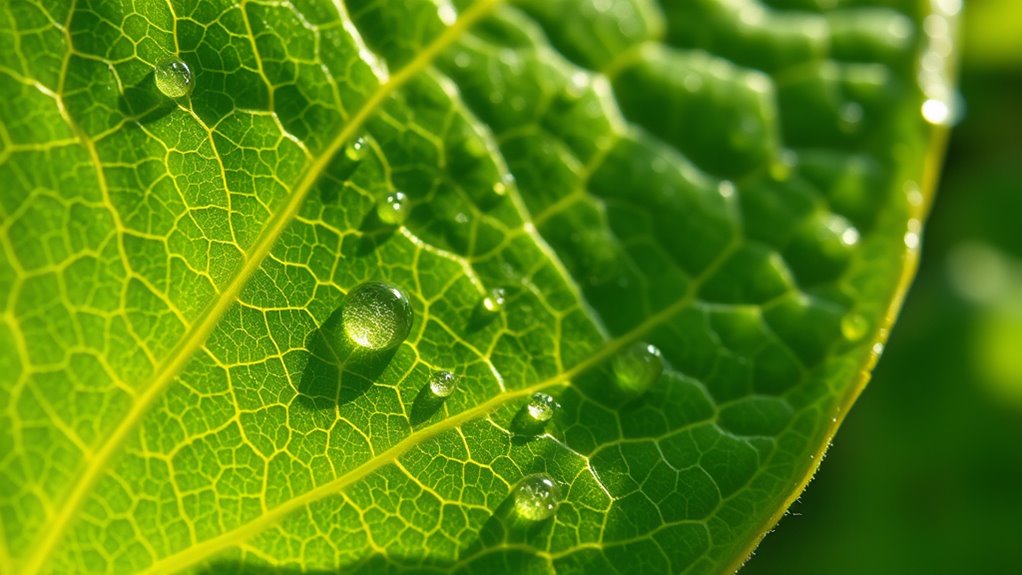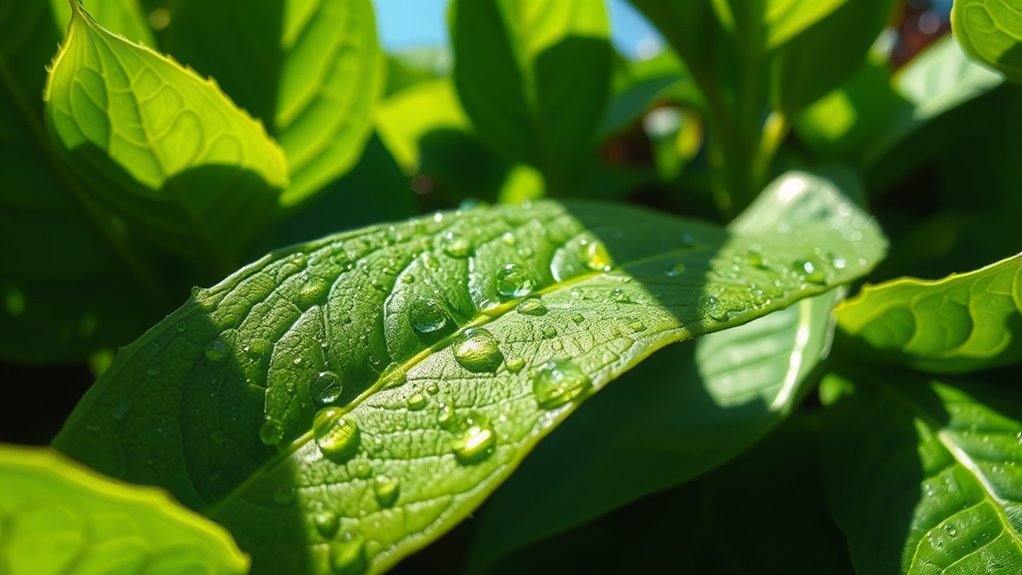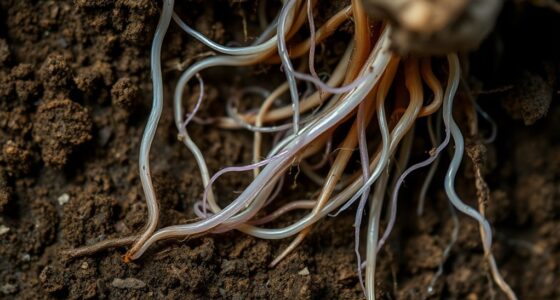Plants defend themselves through immune responses called SAR and ISR. SAR kicks in after an infection, sending signals across the plant to activate defenses and produce protective chemicals, mainly using salicylic acid. ISR, often triggered by helpful microbes, primes the plant’s immune system via jasmonic acid and ethylene pathways. Additionally, plants remember past attacks through biochemical changes, making them respond faster next time. To uncover how these systems work together, continue to explore this fascinating plant defense machinery.
Key Takeaways
- SAR is a systemic defense activated after local infection, involving salicylic acid and defense gene activation throughout the plant.
- ISR is triggered by beneficial microbes, priming the plant’s immune response via jasmonic acid and ethylene pathways.
- Plants develop biochemical “memory” of attacks, enabling quicker and stronger defenses upon subsequent threats.
- These immune responses reduce reliance on chemicals, promoting sustainable crop protection and food security.
- Understanding SAR, ISR, and plant memory aids in developing disease-resistant crops and better management strategies.

Have you ever wondered how plants defend themselves against diseases? Unlike animals, they can’t run away or call for help. Instead, they rely on an intricate immune system that recognizes threats and responds swiftly to protect their essential tissues. When a pathogen attacks, plants activate a complex network of defenses, involving both immediate responses and longer-lasting memories of past encounters. These defenses fall into two major categories: Systemic Acquired Resistance (SAR) and Induced Systemic Resistance (ISR). Understanding these mechanisms reveals how plants not only fight off current infections but also prepare for future threats.
SAR is triggered after a plant experiences a localized infection. Once the plant detects a pathogen, it sends signals throughout its tissues, alerting itself to the threat. These signals activate a suite of defense genes, producing protective chemicals like pathogenesis-related proteins. The result is a heightened state of alert that persists long after the initial attack has been contained. This “immune memory” allows the plant to respond more rapidly and robustly if the same or similar pathogens attempt to invade again. It’s akin to a vaccination in humans, where exposure to a pathogen primes the immune system for future encounters. SAR relies heavily on signaling molecules such as salicylic acid, which orchestrate the systemic response.
On the other hand, ISR is typically triggered by beneficial microbes residing in the soil, such as certain bacteria. These microbes “train” the plant’s immune system, priming it to react more efficiently when actual pathogens appear. Unlike SAR, which is dependent on salicylic acid, ISR often involves signaling pathways related to jasmonic acid and ethylene. When these pathways are activated by beneficial microbes, the plant’s defenses become more responsive but don’t produce the same high levels of defense chemicals as SAR does. This form of priming is more subtle but equally effective, creating a vigilant yet balanced readiness against potential diseases.
Both SAR and ISR demonstrate that plants are not passive organisms but active defenders with a kind of immunological memory. This memory isn’t like our memory, stored in brains, but a biochemical record that influences how the plant responds to future infections. It’s a clever system that enhances survival without the need for an adaptive immune system like ours. By understanding these processes, scientists can develop better strategies to protect crops and ensure food security, harnessing the plant’s own immune machinery to fight off diseases more effectively.
Frequently Asked Questions
How Do Plants Differentiate Between Harmful and Harmless Microbes?
You can understand that plants differentiate between harmful and harmless microbes by detecting specific molecular patterns. Harmful microbes often display unique molecules like pathogen-associated molecular patterns (PAMPs), which plants recognize using pattern recognition receptors (PRRs). When PRRs detect PAMPs, your plant triggers immune responses to fend off the threat. Harmless microbes typically lack these patterns, allowing the plant to tolerate their presence without activating defense mechanisms.
Can Plant Immunity Be Transferred Between Different Plant Species?
Yes, plant immunity can be transferred between different plant species through processes like cross-species grafting or the application of immune-boosting compounds such as elicitors. When you introduce these signals or materials, you activate defense responses in the recipient plant, enhancing its resistance. This transfer relies on the movement of signaling molecules or immune signals, enabling different plant species to share some aspects of their immune responses and improve overall pathogen resistance.
What Environmental Factors Influence Plant Immune Responses?
Imagine your plant standing strong against pests, its defenses shaped by sunlight filtering through leaves and raindrops nourishing roots. Environmental factors like temperature, humidity, and soil quality directly impact its immune responses. High humidity can boost pathogen growth, overwhelming defenses, while ideal temperatures strengthen immune signaling. Light influences hormone production, and stress from drought or pollution can weaken its resilience, making your plant more vulnerable to attacks.
Are There Any Known Trade-Offs Between Growth and Immunity in Plants?
Yes, there are trade-offs between growth and immunity in plants. When plants activate defense mechanisms, they often divert resources from growth processes to prioritize immunity. This means that if your plant invests heavily in defense, it might grow more slowly or produce fewer flowers and fruits. Balancing these responses is essential for peak health, and environmental conditions can influence how plants allocate resources between growth and defense.
How Do Plants Remember Past Infections at the Molecular Level?
Did you know plants can “remember” past infections for weeks or even months? At the molecular level, they store this memory through epigenetic changes—modifications to DNA or histones—that keep defense genes ready to activate quickly upon re-infection. You can think of it as a biological memo, allowing plants to respond faster and more robustly, enhancing their survival without the need for immune cells like in animals.
Conclusion
As you explore plant immunity, remember that SAR, ISR, and immune memory form an unbreakable shield against threats. Like a seasoned warrior, your plants remember past attacks, ready to defend again. Isn’t it remarkable how nature’s silent guardians stand vigilant, turning every challenge into an opportunity for stronger resilience? Embrace this knowledge, and you’ll see the incredible strength hidden within every leaf—proof that even the smallest defenses can change the course of a battle.










